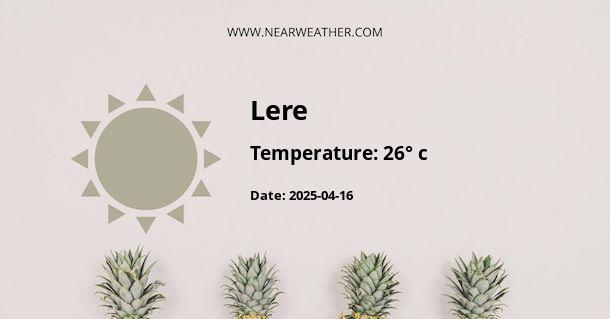Lere, Nigeria: Climate and Weather Year Round
Lere is a town located in the northern part of Nigeria, specifically in the Bauchi State. It is known for its unique climate and weather conditions throughout the year. Understanding the climate and weather patterns in Lere can be helpful for residents and visitors alike. In this article, we will explore the various aspects of Lere's climate, including temperature, precipitation, and seasonal variations.
Temperature
Lere experiences a hot semi-arid climate, with warm temperatures prevailing throughout the year. The town is located in the Sahel region, which is characterized by its proximity to the Sahara Desert. As a result, Lere experiences high temperatures, especially during the dry season.
The average annual temperature in Lere is around 27°C (81°F). During the hottest months, which are typically March and April, temperatures can reach as high as 40°C (104°F) during the day. The nights are relatively cooler, with temperatures dropping to around 20°C (68°F).
During the cooler months, from November to February, temperatures range from 15°C (59°F) to 25°C (77°F) during the day. The nights can be chilly, with temperatures dropping to around 10°C (50°F).
Precipitation
Lere experiences a distinct wet and dry season, with most of the rainfall occurring during the wet season. The wet season in Lere typically begins in May and lasts until September, with July and August being the peak months for rainfall.
The average annual rainfall in Lere is around 800-900mm (31-35 inches). During the wet season, heavy showers and thunderstorms are common, often accompanied by strong winds. The rainfall helps to cool down the temperatures and provide relief from the intense heat.
On the other hand, the dry season in Lere extends from October to April. During this period, the town experiences very little rainfall, if any. The dry season is characterized by hot and dusty conditions, with low humidity levels. Dust storms are occasionally observed, especially in the months of February and March.
Seasonal Variations
Lere experiences distinct seasonal variations, with noticeable changes in temperature and precipitation patterns. The transition from the dry season to the wet season brings relief from the intense heat and dust, as the rainfall helps to cool down the environment.
During the wet season, the landscape in Lere transforms into lush greenery, with vegetation flourishing. This is a favorable time for agriculture, as the rainfall provides sufficient water for crops to grow. However, excessive rainfall can sometimes lead to flooding in low-lying areas, so precautions need to be taken.
The dry season, on the other hand, is characterized by dry and arid conditions. Vegetation becomes sparse, and water sources may dry up, making it challenging for agriculture and livestock rearing. It is important to conserve water during this period to ensure a sustainable water supply.
Conclusion
Lere, Nigeria experiences a hot semi-arid climate with distinct wet and dry seasons. The town's proximity to the Sahara Desert influences its weather patterns, with high temperatures and low rainfall during the dry season. The wet season brings relief from the heat, with heavy rainfall and cooler temperatures. Understanding the climate and weather in Lere can help residents and visitors plan their activities and make necessary preparations accordingly.
A - Lere's Latitude is 10.386970 & Longitude is 8.572620.
A - Weather in Lere is 26° today.
A - Climate Conditions in Lere shows few clouds today.
A - Humidity in Lere is 20% today.
A - Wind speed in Lere is 4.97 km/h, flowing at 220° wind direction. today.
